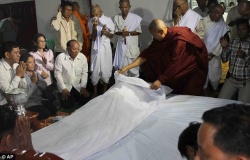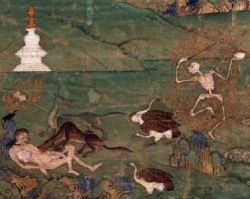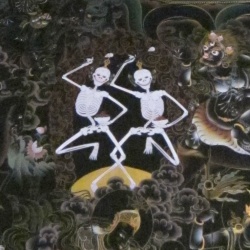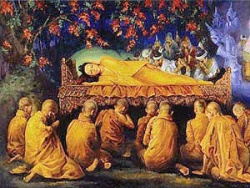Difference between revisions of "A Buddhist's Death"
m (1 revision: Adminos 7 october) |
|
(No difference)
| |
Revision as of 02:03, 7 October 2013
A Buddhist's life is practice for death - cultivating positive, happy virtuous states of mind and abandoning non-virtuous, harmful, suffering states of mind.
Death is definite but the time of death is indefinite so a Buddhist aspires to be ready by being mindful of the preciousness of life and the uncertainness of its length.
Death is an opportunity for great spiritual achievement if one is prepared and remembers one's spiritual practices and beliefs / understandings during the death process.
Death is the separation of body (physical form) and "mind" formless, clear, luminous and knowing. (Only the most subtle level of mind transmigrates.)
Since the state of mind at the time of death is vitally important, it's most important to die with a calm and peaceful mind; with strong spiritual/ positive thoughts prevailing.
Death is not the stoppage of breathing or heartbeat. Death is a process with stages:
After conception, formation proceeds from subtler to grosser, but at death there is a dissolution from grosser to subtler. The four elements earth (hard substances of the body), water (fluids), fire (heat), wind/air (energy, movement) degenerate and dissolve in sequence and there are external signs and internal visions at each stage.
Stage |
Factors Dissolving |
External Sign |
Internal Sign |
1 |
Eye sense; | Body becomes thin, shrinks, weaker. Doesn't tolerate weight of bed clothes. Eyesight becomes unclear; |
|
2 |
Ear sense; | Body fluids dry up; Body becomes numb; |
Smoke |
3 |
Nose sense; | Digestion ceases; Forget life's affairs; |
Sparks |
4 |
Compositional factors aggregate; |
Breathing ceases; Winds move to heart; |
Dying flame |
5 |
Consciousness aggregate; |
Winds above heart enter into central channel. |
White appearance |
6 |
Mind of white appearance |
Winds below heart enter central channel |
Red increase appearance |
7 |
Darkness, then unconsciousness | ||
8 |
Mind of black near-attainment. |
When the Clear Light state finishes, Death is completed and then the "very subtle mind" enters the Intermediate State.
Up to this time the body of the deceased should not be moved and preferably not even touched.
The Clear Light State can last for few minutes (where there is much disease or in accidents) or 3 days (recommended waiting time) or longer in accomplished meditators.
When all the heat has left the body the Clear Light is finished. The heart area retains the heat longest.
Other Signs: a small amount of blood leaves the nose (female) or a small amount of white fluid leaves the penis. These may not occur in bodies wasted by disease. At this point the body begins to rot and smell.
It's best if the body is not touched until a Buddhist Monk, Nun or Lay Practitioner can do the recommended prayers. If the body must be moved, then touch the top of the head and /or pull the hair on the crown first before touching any other part of the body. If there is a Buddhist Stupa, text (scripture) or statue, it's best to use these to touch the crown of the head. And make prayers or good wishes for their peace and passing.
Different Buddhist cultures (Western, Tibetan, Japanese, Korean, Taiwanese, Sri Lankan etc. have different lengths of time that they don't move the body and keep vigil and do prayers). If the Buddhist has no temple/community or the family doesn't know what's available contact Amitabha Hospice Service (09) 828-3321. Rituals will depend on the culture.
Well trained Buddhists will not cry or show strong emotion near the body during the death process. Provide a quiet space away from the body if possible and support as you would anyone with loss.
Buddhists believe that a happy, positive, peaceful mind creates a life of good deeds and morality, which produces a happy, fortunate rebirth. Bereaved Buddhists want the deceased to achieve this and will continue to do prayers and rituals for 49 days (the end of the Intermediate State when Rebirth takes place).
HELPFUL SUPPORT FOR A HAPPY SUCCESSFUL DEATH:
LISTEN and ACKNOWLEDGE WITHOUT JUDGEMENT WHAT IS SHARED
FOCUS ON THE POSITIVE and ENCOURAGE REJOICING, which lifts the mind and increases one's spiritual strength (Acknowledge "regrets" as lessons learned but discourage guilt which is destructive.)
SUPPORT 'LETTING GO' or SEPARATION and GIVING UP EVERYTHING (even "unfinished business" This assistance and the next two are used whether the person is conscious or unconscious.)
CORROBORATE FAITH, DEVOTION and CONFIDENCE (remind them of their spiritual teachers, particular meditation practices, personal deities, etc. Put Buddhist pictures, statues etc in their view; their meditation beads in their hands.)
ENCOURAGE UNIVERSAL LOVE and the ALTRUISTIC ASPIRATION to serve others and continue one's spiritual practice through death, the intermediate state and all future lives.




